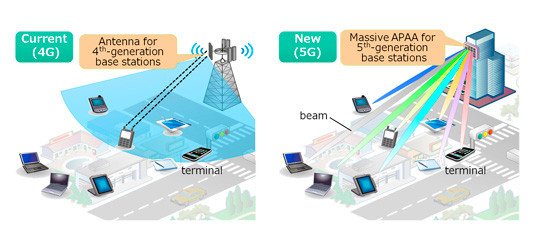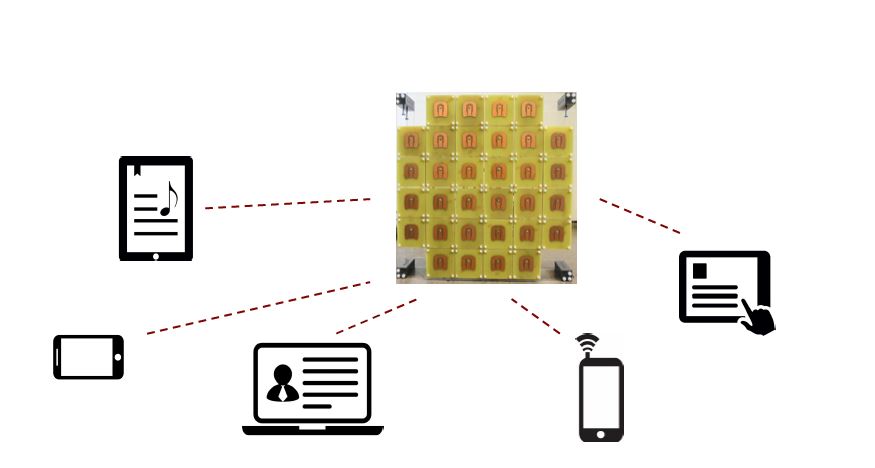Verizon, Qualcomm, and Ericsson collaborate on successful Massive MIMO Trial
Verizon said in a press release that it completed the first successful FDD (Frequency Division Duplexing) massive MIMO (Multiple Input Multiple Output) trial with a fully compatible customer device thanks to its collaboration with Ericsson and Qualcomm. The trial included the use of the latest Ericsson massive MIMO software and hardware along with a mobile test device powered by Qualcomm’s Snapdragon 845 Mobile Platform with an X20 LTE modem.
According to the aforementioned press release:
Massive MIMO is a key technology component in the evolution towards 5G. It has the potential of greatly improving network capacity and the customer’s experience. To realize the gains, both the network and devices need to support new TM9 [1] functionality which leverages advanced beam forming schemes between the network equipment and the mobile device. This will raise network spectral efficiency and customer speeds.
Note 1. In 3GPP Release-10 (LTE-Advanced) Transmission Mode 9 (TM9) was introduced. TM9 is designed to help reduce interference between base stations to maximise signal stability and boost performance. The new TM-9 enables the enhancement of network capabilities and performance with minimum addition of overhead. More information on TM9 is here.
………………………………………………………………………………………………………..
Qualcomm introduced the 845 Mobile Platform at the Snapdragon Summit in Hawaii in early December. The trial comes after Verizon and Ericsson deployed massive MIMO on the wireless carrier’s Irvine, Ca network in late October.
“We don’t wait for the future, we build it. And this is another great example of moving the industry forward,” Verizon Chief Network Engineer and Head of Wireless Networks Nicola Palmer said in the release. “Massive MIMO is a critical component of our 4G LTE Advancements and will play an important role in 5G technology that will result in single digit latency and scalability in the billions of connections,” he added.
Joe Glynn, vice president, business development at Qualcomm Technologies, Inc. said: “This milestone further demonstrates Qualcomm Technologies’ leadership and commitment to continually bring innovative technologies to consumers to improve their mobile experiences. We look forward to continuing our work with Verizon and Ericsson to push the limits of LTE while ushering in a world of 5G.”
Massive MIMO is an LTE Advanced (4G) technology which has been described as being akin to a set of focused flashlights targeting users rather than a single floodlight. The high number of transmitters enables more possible signal paths and beam forming, which directs the beam from the cell site directly to where the customer is located, dramatically cutting down on interference.
Figure 1. Massive MIMO exploits large antenna arrays to spatially multiplex many terminals.
……………………………………………………………………………………………………………………………….

Figure 2. Active Phased Array Antenna (APAA) shown above right in 5G base stations. The combination of analog beam forming via APAA and digital MIMO signal processing for the multi-beam multiplexing is believed to be one of the promising approaches for reducing the complexity and power consumption of 5G base stations. However, that has yet to be proven in a commercial 5G deployment.
………………………………………………………………………………………………………………………………….
In October, Verizon and Ericsson announced they had achieved a milestone in LTE Advanced technologies by completing their first deployment of FDD massive MIMO on Verizon’s wireless network in Irvine, California. Massive MIMO improves both spectral and energy efficiency, increasing network capacity for currently compatible devices in the market. Customers experience higher and more consistent speeds when using apps and uploading and downloading files.
Ericsson’s massive MIMO portfolio is expected to be available next year, putting it in line with commercial smartphones with the TM9 compatible chipset, which are expected to hit the market in the first half of 2018.
The past year saw a lot of talk around massive MIMO, which is considered by many to be a foundation technology for 5G. At the inaugural Mobile World Congress Americas in September, Sprint and Ericsson unveiled results of 2.5 GHz massive MIMO field tests conducted in Seattle and Plano, Texas, using Sprint’s spectrum and Ericsson’s radios.
- In early September, Ericsson said massive MIMO was part of a trial with T-Mobile US using mid-band FDD spectrum on three sites in Baltimore, Maryland.
- In February, Blue Danube Systems announced the completion of commercial trials using its massive MIMO technology in licensed FDD LTE spectrum with AT&T and Shentel.
Niklas Heuveldop, Head of Market Area North America, Ericsson, said: “Advanced Antenna Systems and Massive MIMO are key technology enablers for 5G, and 4G LTE service providers and end users will also benefit from the superior capacity and network performance these technologies enable. The latest trial is another important step in the collaboration we have with Verizon and Qualcomm Technologies to further evolve 4G and prepare the network for 5G.”
The Ericsson Massive MIMO portfolio is expected to be available next year, putting it well in line with commercial smartphones with the TM9 compatible chipset, which are expected to hit the markets in the first half of 2018.
References:
http://www.samsung.com/global/business-images/insights/2017/Massive-MIMO-Comes-of-Age-0.pdf
http://www.ni.com/white-paper/52382/en/
https://techblog.comsoc.org/2017/10/17/mimo-starting-to-realize-its-full-potential-in-lte-networks/
https://www.everythingrf.com/News/details/2639-zte-completes-massive-mimo-tests-for-imt-2020-5g
https://arxiv.org/pdf/1612.03993.pdf
2 thoughts on “Verizon, Qualcomm, and Ericsson collaborate on successful Massive MIMO Trial”
Comments are closed.



Massive MIMO for 5G, by Erik G. Larsson, Linköping University, Linköping, Sweden and Liesbet Van der Perre, KU Leuven, Leuven, Belgium
What is Massive MIMO?
Massive MIMO is the currently most compelling sub-6 GHz physical-layer technology for future wireless access. The main concept is to use large antenna arrays at base stations to simultaneously serve many autonomous terminals. The rich and unique propagation signatures of the terminals are exploited with smart processing at the array to achieve superior capacity. Massive MIMO splendidly offers two most desirable benefits:
1. Excellent spectral efficiency, achieved by spatial multiplexing of many terminals in the same time-frequency resource. Efficient multiplexing requires channels to different terminals to be sufficiently different, which has been shown to hold, theoretically and experimentally, in diverse propagation environments. Specifically, it is known that Massive MIMO works as well in line-of-sight as in rich scattering.
2. Superior energy efficiency, by virtue of the array gain, that permits a reduction of radiated power. Moreover, the ability to achieve excellent performance while operating with low-accuracy signals and linear processing further enables
considerable savings.
……………………………………………………………………………
The key technological characteristics of Massive MIMO are:
1. Fully digital processing; each antenna has its own RF and digital baseband chain. Signals from all antennas at each base station are processed coherently together. Core advantages of fully digital processing include the avoidance of specific assumptions on propagation channel, the possibility to measure the complete channel response on the uplink and respond fast to changes in the channel. Interestingly, recent assessments show that the full digital processing may not only offer superior performance but also better energy efficiency, a trend which may be reinforced by the ongoing development of tailored low-power circuits.
2. The reliance on reciprocity of propagation and TDD operation, enabling downlink channels to be estimated from uplink pilots, and obviating the need for prior or structural knowledge of the propagation channel.
3. Computationally inexpensive precoding/decoding algorithms, taking the form of maximum-ratio (known also as conjugate beamforming) or zero-forcing processing. Massive MIMO functions equally well with single-carrier transmission and OFDM.
4. Notably, conjugate beamforming with OFDM is equivalent to time-reversal in a single-carrier system.
5. Array gain, resulting, in principle, in a closed-loop link budget enhancement proportional to the number of base station antennas.
6. Channel hardening, that effectively removes the effects of fast fading. Operationally, each terminal-base station link becomes a scalar channel whose gain stabilizes to a deterministic and frequency-independent constant. This greatly simplifies resource allocation problems.
7. The provision of uniformly good quality of service to all terminals in a cell — facilitated by the link budget improvement offered by the array gain, and the interference suppression capability offered by the spatial resolution of the array. Typical baseline power control algorithms achieve max-min fairness among the terminals.
8. Autonomous operation of the base stations, with no sharing of payload data or channel state information with other cells, and no requirements of accurate time synchronization.
The possibility to reduce accuracy and resolution of transceiver frontends, and the digital processing and number representations in computations.
9. The attractive properties of propagation — penetration of solid objects and diffractive behavior — and the maturity of hardware renders Massive MIMO primarily a below-6 GHz technology for radio access. This is also the region where spectrum is most valuable. Arrays have attractive form factors even for large numbers of antennas: in the 3.5 GHz TDD band, a half-wavelength-spaced rectangular array with 200 dual-polarized elements is about 0.6 x 0.3 meters large; in practice, larger antenna spacing may be desired and is easily afforded. However, systems operating at higher frequencies up to millimeter-waves may also benefit from the application of Massive MIMO, especially when these systems would need to support multi-user access in potentially non-Line-of-Sight scenarios.
https://5g.ieee.org/tech-focus/march-2017/massive-mimo-for-5g
“We will be the only ones on the fast-track toward a real, mobile nationwide 5G network in 2020 — and have already started deploying 5G ready equipment,” T-Mobile CEO John Legere said in a blog post. This is a reiteration of what T-Mobile, the No. 3 carrier in the US by number of subscribers, has been preaching hard in recent weeks: That it’s ahead of its US rivals when it comes to the next great leap in cellular tech.
https://www.cnet.com/news/t-mobile-john-legere-fast-track-to-5g/